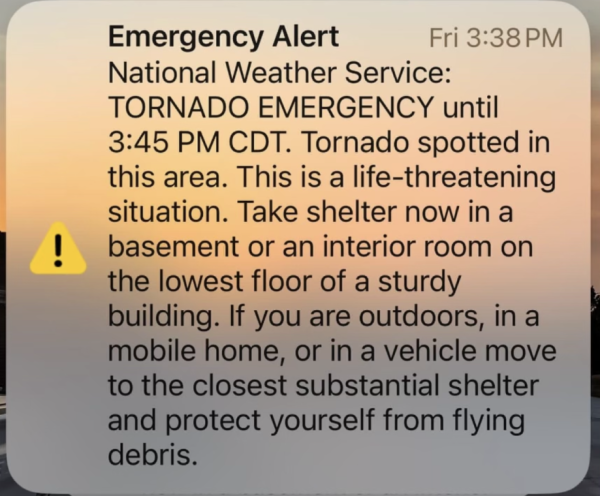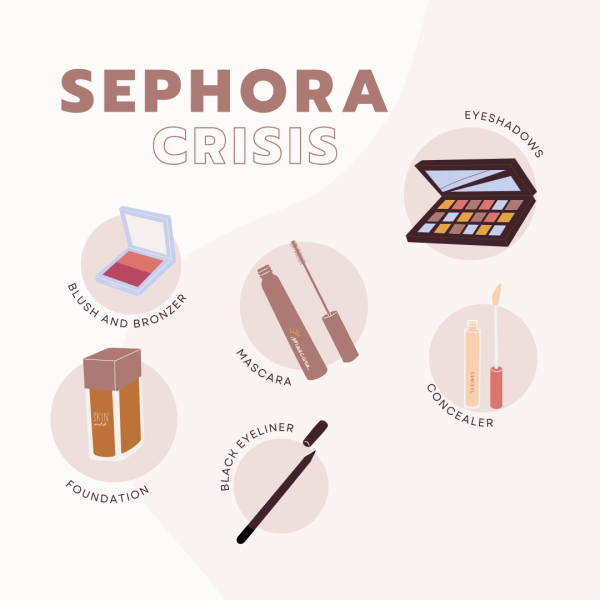Let’s Talk About Sex
Sex education in Nebraska is left up to each district, often leaving students in the dark.
Graphic provided by Elaina Franzen. Artistic depiction of birds and bees.
March 2, 2020

Nebraska allows individual school districts to set the sex education curriculum for their district. This image shows how each Metro area district handles important sex ed issues.
It’s the middle of a Monday and kids shuffle into a small classroom at the far corner of the building. The room has tiny desks attached to squeaky chairs in which equally squeaky freshmen sit. At the front of the classroom is Annie Catania, a first year health and P.E. teacher tasked with teaching sex education. The freshmen in the chairs come from varying backgrounds and identities, and they are about to learn that their sex education is not as straightforward as it should be.
In the United States, only 13 states require information on sex education to be medically accurate. This can mean that a lot of what is taught to students is unregulated and in some cases, incomplete. For some, the majority of the information they receive regarding sex education comes from the school curriculum. Because of this, it’s important that students receive complete information to ensure that every child is equipped to make healthy and appropriate decisions. But with a classroom full of students – each different in their own regard – this isn’t quite as straightforward as it might seem.
In the US, the average age of first sexual intercourse is 17 years old. 20% of 15 year olds and close to half of 17 year olds have engaged in partnered sexual behaviors. Nebraska data revealed that 32.5% of its high school students have had sexual intercourse and approximately 25% of high school students were currently sexually active. Many high school students are sexually active, and need medically accurate information about sex education. Not all get it.
Sex education in public schools in the United States has been a frequent topic of debate, the controversy coming from disagreements over what students should be taught regarding sex. In the 1980’s, abstinence-only-until-marriage education received major federal funding, which promoted abstaining from sex out of wedlock while simultaneously making a point of the failure rates of different methods of birth control – a tactic that seemed intent on scaring students out of sex. This method of sex education showed no evidence of decreasing sexual activity, yet the program has continued to receive more than $1.8 billion in federal funding since 1996. Today, pro-abstinence and abstinence-based sex education programs are the most widely used sex education programs throughout the country.
Although abstinence-only sex education is federally funded, the laws regarding sex education vary greatly from state to state. In 22 states and the District of Columbia, sex education is legally mandated, but only 18 states require information on birth control be taught.
Similarly, conversations about gender identity and sexual orientation are often left out of the classroom. In some cases, states make efforts to further exclude people by enacting laws and policies that prohibit the inclusion of LGBTQ content. The teaching of LGBTQ related content is explicitly restricted in eight states: Alabama, Arizona, Louisiana, Mississippi, Oklahoma, South Carolina, Texas, and Utah.
According to the Gay Lesbian and Straight Education Network (GLSEN), in Alabama, teachers are required to “emphasize […] that homosexuality is not a lifestyle acceptable to the general public and that homosexual conduct is a criminal offense under the laws of the state.” Conversely, there are only four states that have state laws or guidance that require sex education to be specifically inclusive of LGBTQ youth: California, Colorado, Iowa, and Washington.
With differing mandates from federal and state officials, it can be a difficult task for educators to provide students a complete view of sex education and sexuality.
Lisa Schulze is trying to change that. She serves as the Education and Training Manager for the Women’s Fund of Omaha. She’s an AASECT (American Association of Sexuality Educators, Counselors, and Therapists) certified sex educator with a Masters of Education in Human Sexuality, and has served as a sex educator for 20 years. Her work with Nebraska schools has involved the implementation of a comprehensive sex education program.
Comprehensive Sex Education (CSE) provides science-based, medically accurate and complete, age, developmentally, and culturally appropriate sexual health information to address the physical, mental, emotional, and social dimensions of human sexuality for all young people. It covers the physical aspects involving sex, but also the emotional and psycho-social components that can affect students. Abstinence-only sex education often excludes information on sexual and reproductive health such as birth control and safe sex, while CSE covers the use of birth control and sexual abstinence.
“Complete, honest, effective sex education allows young people to make informed decisions about their sexual health,” Schulze said. “Access to effective sex ed increases academic success and positive health outcomes.”
– Nebraska/Elkhorn Policy –
Nebraska law, Revised Statutes Chapter 79 Section 712, does not require sexuality education, and it does not limit or specifically state what can be taught in class. In the Nebraska Health Education Frameworks, the Nebraska State Board of Education supports “an abstinence approach to risk behaviors associated with […] sexual activity” and declares that all “state monies shall be dedicated to abstinence programs.” Most districts are left to decide what they believe to be most effective for their community. Many schools, including Elkhorn, defer to the school board to help determine what is permitted in the curriculum.
Elkhorn’s policy, 604.04 Health Education, specifically states that “the district shall provide students with comprehensive health education in compliance with state and federal law” and “the Board endorses the position of current medical research that school age, family life, and sex education be abstinence based.”
Comprehensive and abstinence-based are two different forms of sex education, and Schulze said only one Metro area district meets the criteria.
“Omaha Public Schools is really the only [district] considered to have comprehensive sex education according to the standards, Schulze, who worked with OPS to create their program said. “That means the comprehensive sex education program includes abstinence and delaying sex, but also includes information around accessing contraceptive options and talking about our inter-sexual identities, particularly around sexual education, gender identity, and gender expression.”
Dr. Cindy Gray, Elkhorn Associate Superintendent, said the Elkhorn Public Schools curriculum is updated every seven years based on what the school board deems necessary.
“When I first came here the health curriculum was very old because it had become so controversial to even bring up the topic that people were skittish about trying to adopt something new,” Gray said. “This is an area where we have a very tight line to walk and try to be respectful of our parents and our students. There are some people that feel like we don’t give enough information to the students, and there are others that feel like we are giving so much information we could promote promiscuity. We have to be careful about being factual and not representing a viewpoint.”
Factual information should be the fundamental base of sex education, but being factual in certain areas while simultaneously avoiding areas like contraception can be detrimental to the students, Schulze said.
Catania, teaching Elkhorn’s curriculum for the first time this year said teachers are given very specific guidelines to follow, and certain topics can only be discussed if a student asks. Topics like abortion and the LGBTQ community are not in the curriculum.
Catania said the organizational structure Elkhorn uses for health class can limit the ability to provide comprehensive information.
“Half of our time is in the heath room, and half of our time is in the gym,” Catania said. “I don’t think that necessarily gives us enough time to cover everything.
Dr. Gray said she believes Elkhorn does provide complete sex education.
“Certainly we are not at the extreme of what would be called comprehensive,” Gray said. “Comprehensive, I think, means a different thing today than it did ten years ago. If you look at the sex education that happened 15 years ago, you would see that it is different than what is happening today.”
Whether Elkhorn’s sexual education program is truly comprehensive or not, Catania said she feels that despite its limitations, the curriculum adequately prepares students for real life.
“I think it gives them a decent foundation,” she said, “Students need a more comprehensive class on sex education because they’re going to have these experiences in their life, and I want them to be prepared to make the healthiest option for themselves because they are going to interact with people who are different than they are. By taking a comprehensive approach, we can better prepare students for that.”
– Truly Comprehensive –
Technically speaking, Omaha Public Schools (OPS), is the only district in the state of Nebraska considered to have comprehensive sex education. In that district’s curriculum, students are taught that discovering one’s gender identity and sexual orientation is a normal process, and an emphasis is placed an on teachers using gender-neutral terms such as “partner” rather than “boyfriend” or “girlfriend.”
Dr. Gray said Elkhorn’s policy on the inclusion of information about sexual orientation was evolving.
“We have struggled to find materials that stay pretty factual on that topic, but in the last round we certainly added some new informational pieces,” Gray said.
Elkhorn is considered to be an affluent school district, but still has student families from all income levels, and sexual orientations.
Schulze said demographics and socio-economic status shouldn’t play any role in sex education curriculum.
“Students of all identities, including those with many resources and those who are struggling, are all sexual beings and have fundamental rights to sex education,” Schultze said. “I think the culture of silence and culture of shame can perpetuate itself in multiple communities, but sometimes there is a sense of ‘that doesn’t happen here’ and so people deal with it quietly. What happens a lot is people suffer in silence especially if their existence isn’t reflected in the curriculum, so we know across all identities and all socioeconomic statuses that people are sexually active and that we need to require LGBTQ inclusive sex education, and that leads to positive health outcomes.”
Schulze said it is important that districts are proactively providing comprehensive sex education.
“There are many folks that are worried like ‘Oh its controversial to be providing complete honest medically accurate information’ – but I think we need to flip the narrative so it’s controversial to not provide that.”
The statistics seem to agree, showing that districts are not doing enough for students. Of those in high school who are sexually active, 43% did not use a condom during their last sexual intercourse encounter. Further, 18% did not use any form of contraception.
Schulze said it’s important that we’re proactively providing complete and honest information so people can make informed decisions about their sexual health. With that information, they are going to be healthier, happier, and have better relationships – not the other way around.
According to the Sexuality Information and Education Council of the United States (SIECUS), which issues reports on sexual activity and education nationally, abstinence-only programs have not been proven to delay sexual activity, decrease sexual activity, or decrease negative sexual health outcomes. Programs that incorporate elements of CSE have been shown to improve academic success; prevent child sexual abuse, dating violence, and bullying; help younger people develop healthier relationships; delay sexual initiation; reduce unintended pregnancy, HIV, and other STIs; and reduce sexual health disparities among LGBTQ youth. Decades of research show sexual health education programs that include information on condoms and contraception – in addition to abstinence – effectively delay sexual activity as well as increase condom and contraceptive use when young people do become sexually active. SIECUS said professional health organizations, young people, and even parents agree: this type of sexuality education should be taught in the classroom.
Conversations about sex education aren’t easy ones to have. The topic of sex is so stigmatized that people often lose sight of what’s most beneficial to the students.
“I think its important that we also talk about the fact that comprehensive sex education is a protection factor for sexual violence,” Schultze said, “people are afraid to talk about adolescent sexuality in honest, open, age-appropriate ways then we’re also contributing to a culture of shame and silence that can perpetuate sexual violence.”
The problem is that teenage sexuality has become political. Even though the research clearly supports comprehensive sex education, the default has become to control and contain adolescent sexuality. But the school systems can’t shoulder all the blame for this. Sex education in school is only meant to add on to what is happening in the home. Parents are the primary sex educators of their children whether they’re talking or not. We all struggle to have effective communication around consent, intimacy, and healthy relationships, but it’s not optional.
Every day, students walk into rooms at the far end of schools with squeaky chairs just like Catania’s, and they shouldn’t have to wonder if they’re getting the whole story.














